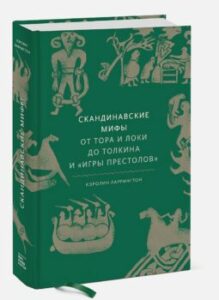Описание книги
More info An exciting introduction to the vibrant, violent and noisy world of Scandinavian myths and their legacy — from Tolkien to Game of Thrones. In Scandinavian myths, the infamous Viking gods are represented — from the powerful Asher led by Einn and the mysterious Vanir to Thor and the mythological space in which they inhabit. Fragments from legends bring this world of myths to life — from the creation of the world to Ragnarok, the predicted end of the world from the army of monsters and Loki, and everything in between: the problematic relationship between gods and giants, the unsuccessful adventures of human heroes and heroines, their family feuds, revenge, marriages and murders, interactions between gods and mortals. Photos and drawings show a range of Norse sites, objects and characters — from the burials of Viking ships to dragons on stones with hands. Professor Carolyn Larrington discusses the origins of Scandinavian myths in pre-Christian Scandinavia and Iceland and their survival in archaeological artifacts and written sources, from Old Norse sagas and poems to less approving descriptions of medieval Christian writers. She traces their influence in the works of Wagner, William Morris and JRR Tolkien, and even in Game of Thrones in the resurrection of Fimbulvetra, or Mighty Winter. From the author Who are the Norse or Scandinavian gods? Migrants from the Middle East who traveled through Germany and found a new home in Scandinavia: people like you and me, only smarter, more beautiful, more civilized than all of us. Medieval Christian scholars wanted to explain why their ancestors worshiped false gods, and one of the theories said that the pre-Christian gods were demons, evil spirits sent by Satan to tempt people, entice them into sins and delusions. Another, very convincing theory formed the basis of the text quoted above by Snorri Sturluson: the so-called gods were, in fact, exceptional people, immigrants from Troy, this idea was later called the term euhemerism. For Snorri Sturluson, an Icelandic scientist, politician, poet and military leader of the 13th century, who left us the most complete and systematic collection of legends about the Norse pantheon, the idea that the Scandinavian gods — they were called ases — must be outstanding people seemed very attractive. The descendants of the Trojans who lost the war decided to migrate north and brought with them superior technology and knowledge to the peoples of Germany and Scandinavia. The culture of the newcomers was superior to that of the earlier settlers, so that they adopted the language of those who appeared, and after the death of the first generation of settlers they began to worship them as gods. Who is this book for? For history buffs, fans of modern superheroes, connoisseurs of the Scandinavian gods, and those who want to learn more about Odin and Loki. …
FAQ
